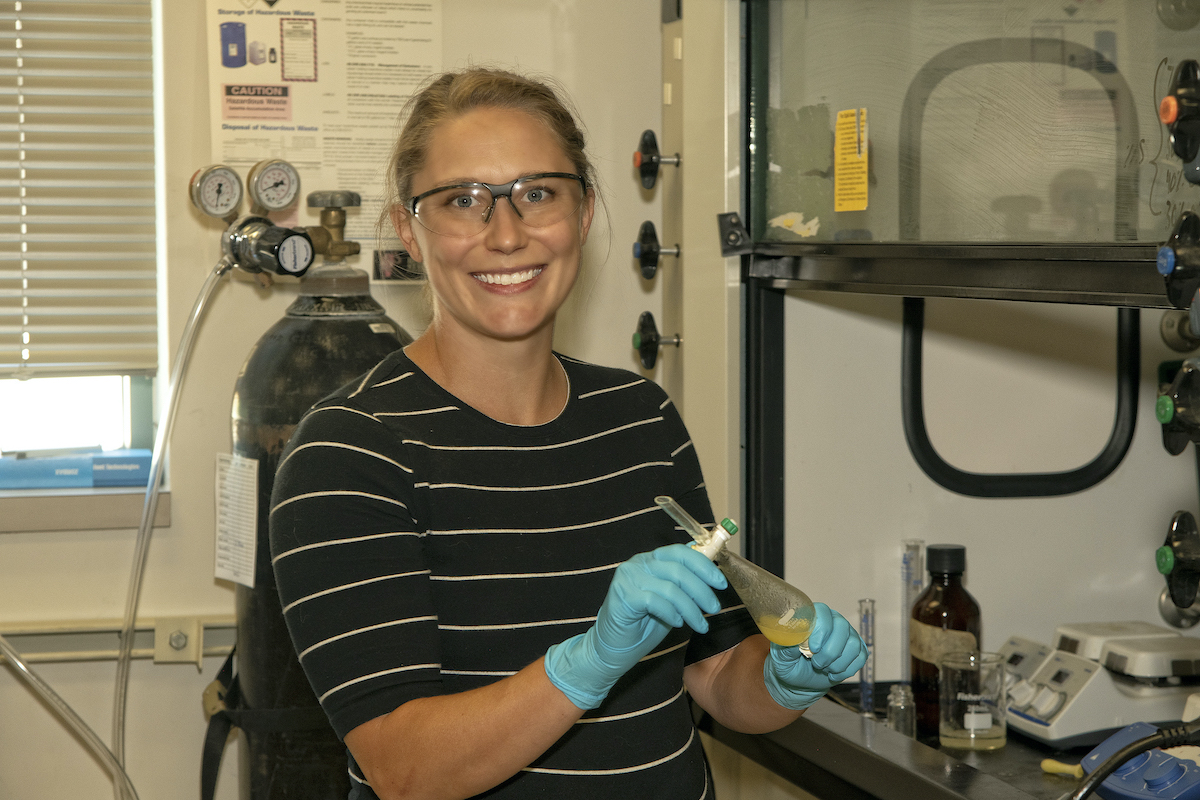ISU chemistry Professor Jenkins lands $308k NSF grant to use waste sulfur to remove contaminants from wastewater, create greener glues
July 13, 2020

POCATELLO – Each year worldwide about 150 billion pounds of elemental sulfur waste is produced from refining crude oil and Idaho State University chemistry Assistant Professor Courtney Jenkins, assisted by a team of ISU undergraduate students, is trying to create functional materials from it.
“We want to take a waste product, recycle it into something useful to either remove heavy metals or use that waste product to remediate (clean up) waste, or use this waste to create a new greener material,” Jenkins said, referring to her lab’s newest project funded by a three-year $308,000 National Science Foundation grant.
Jenkins is a chemist who works with polymers, more commonly known as plastics, which have a molecular structure consisting of a large number of similar units bonded together. Her lab will be working with sulfur-based polymers.
“We just start with plain elemental sulfur, that yellow substance people think of, and we turn that into a material using different monomers, which are different small molecules bonded to form polymers, to make the sulfur polymers water soluble and help them bind with heavy metals that are problematic in the environment,” Jenkins said. “We will take that waste product and combine it to make a functional material and so then it gives you just this really cheap, inexpensive material that you could use to remove heavy-metal contaminants from wastewater.”
The other piece of the project is making adhesives, or glues, that are used in a variety of industries including the automobile and aerospace industries. A lot of glues are made with harsh chemicals that release harmful volatile organic compounds (VOCs) so Jenkins lab is trying to limit their release. Her lab will try to mix sulfur with natural monomers that can be extracted from plants such as garlic and from native Idaho plants.
“We will be using some of these plant oils in combination with sulfur to make adhesive material and the benefit of that is so we don’t have to use any solvents,” Jenkins said. “So when people think about volatile chemicals and those things getting into the air, here we don’t have to use any of those solvents or additional components so it makes it better for the environment to create glues from renewables and waste components.”
Native plants her lab will explore using include juniper tree and curlycup gumweed essential oils with help from ISU chemistry Research Professor Kavita Sharma’s laboratory.
“Adhesives are kind of ubiquitous – they are in cars, they are in furniture, in your shoes, they are kind of everywhere – so the more we can use green chemistry, recycled materials and renewable materials to make these adhesives, the better products we will be able to make,” Jenkins said.
The title of her grant is “Recycling Sulfur Petroleum Waste to Fabricate Metal Captures and Adhesive Polysulfides” which she received from the NSF’s Division of Material Science within the Polymer Division. A major reason she received the grant is that her lab and the entire ISU Department of Chemistry focuses on undergraduate research opportunities. She will be employing at least four undergraduates on this project during its first year.
“A lot of departments are doing this type of work with PhD students and postdocs but a big part of what we do in the ISU chemistry department is specifically focused on undergraduate training, so that is a big piece of this grant,” Jenkins said. “The more we can use our students and train them and help them to be successful beyond here is really important.”
Categories:
